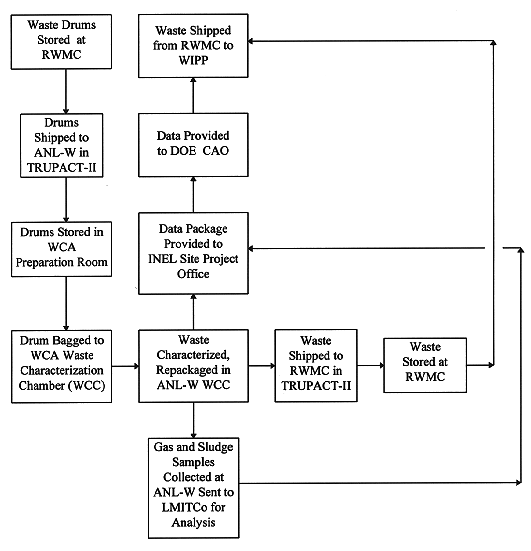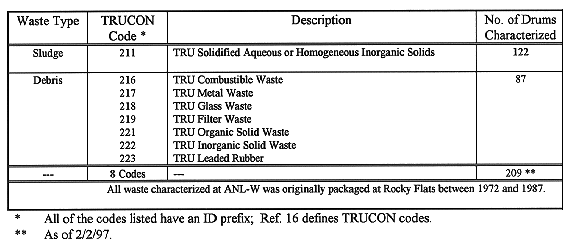
Fig. 1. TWCP waste
characterization process flow diagram.
Carla C. Dwight, Bruce A. Jensen, C. Dwayne Bryngelson, and
David S. Duncan
Argonne National Laboratory-West
ABSTRACT
Argonne National Laboratory and Lockheed Martin Idaho Technologies Company have jointly participated in the Department of Energy's (DOE) Waste Isolation Pilot Plant (WIPP) Transuranic Waste Characterization Program since 1990. Intrusive examinations have been conducted in the Waste Characterization Area, located at Argonne-West in Idaho Falls, Idaho, on over 200 drums of mixed contact-handled transuranic waste. This is double the number of drums characterized since the last update at the 1995 Waste Management Conference. These examinations have provided waste characterization information that supports performance assessment of WIPP and that supports Lockheed's compliance with the Resource Conservation and Recovery Act. Operating philosophies and corresponding regulatory permits have been broadened to provide greater flexibility and capability for waste characterization, such as the provision for minor treatments like absorption, neutralization, stabilization, and amalgamation. This paper provides an update on Argonne's intrusive characterization permits, procedures, results, and lessons learned. Other DOE sites that must deal with mixed contact-handled transuranic waste have initiated detailed planning for characterization of their own waste. The information presented herein could aid these other storage and generator sites in further development of their characterization efforts.
BACKGROUND
Argonne National Laboratory-West (ANL-W) and Lockheed-Martin Idaho Technologies Company (LMITCo) (formerly EG&G Idaho) have jointly participated since 1990 in the Department of Energy's (DOE) Waste Isolation Pilot Plant (WIPP) Transuranic Waste Characterization Program (TWCP) (1), formerly called the WIPP Experimental Test Program (2). Both organizations are located at the Idaho National Engineering Laboratory (INEL), located near Idaho Falls, Idaho. This DOE program is aimed at obtaining data to support technical and regulatory evaluations to qualify the WIPP as a permanent disposal facility for transuranic (TRU) waste. Additionally, the program is aimed at qualifying TRU waste which will eventually be sent to WIPP for disposal. Waste characterization conducted by Argonne and LMITCO at the INEL continue to serve both of these objectives. As well as meeting WIPP needs, waste characterization supports compliance with regulations that govern waste storage at Lockheed's Radioactive Waste Management Complex (RWMC) at the INEL. Over 130,000 drums (55-gallon size) of contact-handled, TRU waste (CH-TRU) are currently stored at the RWMC (3). The majority of this radioactive waste is also contaminated with hazardous constituents, hence the term "mixed waste." The State of Idaho Department of Environmental Quality regulates storage of mixed waste under the Hazardous Waste Management Act (HWMA) (4), which is Idaho's equivalent to the Resource Conservation and Recovery Act (RCRA) (5).
The Waste Characterization Area (WCA), located in Argonne's Hot Fuel Examination Facility (HFEF), is a unique facility at the INEL that possesses features necessary to safely and efficiently open containers of mixed waste. The facility is thoroughly described in a previous paper (6). Waste characterization to support WIPP and compliance with Idaho HWMA/RCRA requirements was initiated at ANL-W in 1990. Since then, over 200 drums of mixed CH-TRU waste have been characterized in the WCA. Early results were presented in previous Waste Management conferences (7, 8, 9). Since the last report in March 1995, quite a bit more experience has been gained in the characterization process. The lessons learned may be of interest to the other eight major sites in the United States (10) that generate and/or store CH-TRU waste, which are faced with the same requirements to qualify their waste for disposal at WIPP. The INEL was the first site to implement the characterization requirements mandated by DOE; the CH-TRU waste from the INEL is planned to be the first waste shipped to WIPP for disposal.
The remainder of this paper is organized to present: a summary of the characterization process at the INEL; a summary of the permits and authorization bases applicable to Argonne-West characterization facilities and procedures; a summary of the characterization results; and finally, lessons learned.
SUMMARY OF CHARACTERIZATION PROCESS
The characterization process at the INEL is complicated because Argonne's WCA and Lockheed's RWMC are located approximately 32 kilometers apart. A public highway separates the two facilities, which requires waste to be transferred in the TRUPACT-II cask (11). This arrangement resulted from the need in 1990 to quickly put together a program at the INEL for characterizing and repackaging waste. Argonne had the only facilities at the INEL, then and now, where radionuclide confinement, ventilation, and handling features were in place to facilitate the opening of CH-TRU drums which is required to fully characterize the waste. Multiple facilities and organizations are involved in the INEL waste characterization process. Fig. 1 depicts these facilities along with the function that each performs.

Fig. 1. TWCP waste
characterization process flow diagram.
Characterization methods are delineated in DOE's TWCP Methods Manual (12). The methods applicable to Argonne's current role in characterization are headspace gas analysis, sludge sampling, and visual examination. Following characterization at the WCA, drums are repackaged to meet shipping requirements and returned to the RWMC where they are stored until their eventual shipment to WIPP. The characterization results presented in a later section of this paper focus on the activities performed at ANL-W.
PERMITS AND AUTHORIZATION BASES
This section summarizes three areas pertinent to permitting and authorization bases for Argonne's work in mixed transuranic waste characterization. First, environmental permitting issues are addressed, followed by safety and operational authorizations. Finally, programmatic interfaces with the DOE sponsor, the Carlsbad Area Office (CAO) is covered.
Three areas of environmental regulations are applicable: 1) National Environmental Policy Act (NEPA); 2) Clean Air Act (CAA); and 3) RCRA. The initial NEPA evaluations for activities at the INEL were formally issued by DOE in March 1991 (13) under a supplemental analysis to the WIPP Environmental Impact Statement. The analysis was divided into three activities: storage at the RWMC, characterization at ANL-W, and transportation between the RWMC and ANL-W. The analysis concluded that none of the three activities represented any changes from impacts previously analyzed, therefore further documentation was not required in accordance with 10 CFR 1502.9c(2). Argonne performed additional NEPA evaluations for modifications to the WCA, which qualified as categorical exclusions under 10 CFR 1021, Subpart D, Appendix B6.6.
For the CAA, an analysis was performed to determine whether a National Emission Standards for Hazardous Air Pollutants (NESHAP) permit was required (10 CFR 61). No NESHAP permit was required, however, the stack monitoring system in HFEF required compliance with the emission monitoring and test procedures (10 CFR 61.93) because the calculated unmitigated dose at the maximum site boundary exceeded the threshold of 0.1 mrem per year. Actual emissions from the waste characterization operations are negligible, as expected, due to the high efficiency particulate attenuation filters in the facility ventilation system. The Rules and Regulations for the Control of Air Pollution in Idaho (IDAPA 16.01.1002) were reviewed to determine whether a Permit To Construct was required. The State of Idaho agreed that no permit was required.
Under HWMA/RCRA, interim status was granted to Argonne for HFEF by the State of Idaho in November 1990. Since then, five revisions to a Part B RCRA permit application for HFEF have been submitted to the State of Idaho. The first three revisions were made to update the facility configuration as modifications were made to the WCA. In the last two revisions (submitted within the last nine months), the application was revised to allow four minor treatments: absorption, neutralization, stabilization, and amalgamation. These treatment capabilities, once permitted, will allow for greater flexibility in Argonne's waste management operations. Many of the INEL's CH-TRU drums which are planned for disposal at WIPP will require treatment to meet the WIPP waste acceptance criteria. Five storage units are located within HFEF, with a total storage capacity of 195 55-gallon drum equivalents (10,725 gallons).
Safety of the waste characterization activities and facilities at Argonne was analyzed in accordance with DOE guidelines (14). Radiological and chemical hazards were evaluated for normal and accident scenarios. The principal radiological hazards are plutonium and americium. The principal chemical hazards are volatile organic compounds such as trichloroethane, carbon tetrachloride, trichloroethylene, methylene chloride, butyl and methyl alcohol, and xylene; toxic metals such as cadmium, lead, mercury, and beryllium; and asbestos. The six bounding accident scenarios include dropped drums in the truck lock and high bay, fires in the waste storage areasand in the waste characterization chamber (WCC) (primary confinement), spilled drums in the storage areas, and loss of exhaust flow in the WCC. The HFEF is a Hazard Category 2 facility in accordance with DOE guidelines (15); the potential WCA hazards fell within the HFEF designation. Prior to initiation of WCA operations, both initially and again after modifications were made to accommodate sludge sampling, an independent readiness assessment was conducted by Argonne. Equipment, procedures, and personnel were independently verified ready for operations via this process.
One final area worthy of mention in terms of required authorization bases is the interaction among Argonne, Lockheed, and the DOE sponsor for this work, the Carlsbad Area Office (CAO). Each participating site must comply with the Quality Assurance Program Plan (QAPP) (1), which requires that a site Quality Assurance Project Plan (QAPjP) be prepared and approved by CAO. The QAPjP describes the quality assurance program and specific implementing procedures used by the site. Each major facility at the INEL, five total, (e.g., ANL-W, RWMC, and the analytical laboratories) prepared a QAPjP that was approved by CAO; however, to streamline the process, all INEL activities are being incorporated into a single INEL QAPjP which is expected to be submitted to CAO in March 1997. Each site is audited annually to its QAPjP by CAO. The focus of the past two CAO audits of ANL was compliance, as opposed to performance.
CHARACTERIZATION RESULTS AND LESSONS LEARNED
A total of 209 drums were characterized at ANL-W between 1991, when the program was initiated, through February 2, 1997. Table I shows the waste categories and the number of drums in each category. All of the waste characterized was originally packaged at Rocky Flats between 1972 and 1987. Table II provides a summary of various radiological, programmatic, and operational parameters, along with bounding values for comparison. The next section presents some conclusions from the results.
Table I Waste Description and Quantities of Drums Characterized

Table II Summary of Waste Characterization and Operational Data

In almost six years of characterization operations, only the last 4 months represent a "production" mode of operation. Of the total 209 drums characterized, 56 were characterized in the last 4 months. The early years were principally consumed by requirements development, facility and equipment installation and checkout, methods development, and procedure validation. This evolutionary process, which entailed numerous iterations between those organizations specifying, implementing, and verifying the requirements, allowed the requirements to stabilize and the methods to be proven. Other sites that are beginning their characterization programs should benefit from the INEL experience. The following list summarizes ANL-W operations and lessons learned:
REFERENCES
*The submitted manuscript has been authored by a contractor of the U.S. Govrnment under contract No. W-31-109-ENG-38. Accordingly, the U.S. Government retains a non-exclusive, royalty-free license to publish or reproduce the published form of this contribution, or allow others to do so, for U.S. Government purposes.